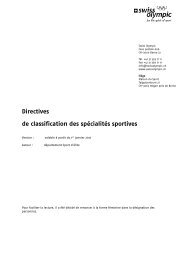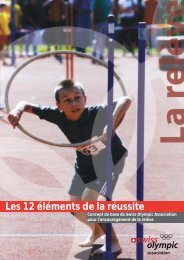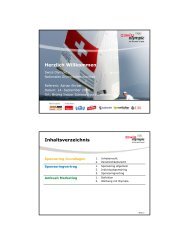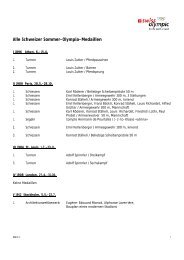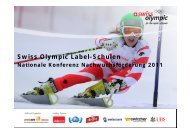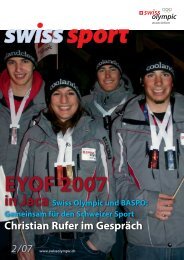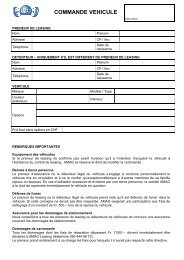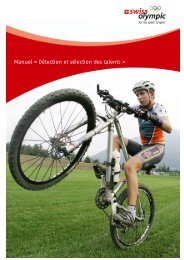Ein Höhentrainingshandbuch für die Praxis - Bundesamt für Sport ...
Ein Höhentrainingshandbuch für die Praxis - Bundesamt für Sport ...
Ein Höhentrainingshandbuch für die Praxis - Bundesamt für Sport ...
Sie wollen auch ein ePaper? Erhöhen Sie die Reichweite Ihrer Titel.
YUMPU macht aus Druck-PDFs automatisch weboptimierte ePaper, die Google liebt.
Swiss Olympic Alto ’06<br />
Höhentraining in der <strong>Praxis</strong><br />
Fulco, C. S., P. B. Rock, and A. Cymerman. Maximal and submaximal exercise performance at altitude. Aviat Space Environ Med.<br />
69:793-801, 1998.<br />
Ge, R. L., S. Witkowski, Y. Zhang, C. Alfrey, M. Sivieri, T. Karlsen, G. K. Resaland, M. Harber, J. Stray-Gundersen, and B. D. Levine.<br />
Determinants of erythropoietin release in response to short-term hypobaric hypoxia. J Appl Physiol. 92:2361-2367, 2002.<br />
Gore, C. J., A. Hahn, A. Rice, P. Bourdon, S. Lawrence, C. Walsh, T. Stanef, P. Barnes, R. Parisotto, D. Martin, D. Pyne, and C. Gore.<br />
Altitude training at 2690m does not increase total haemoglobin mass or sea level VO2max in world champion track cyclists. J Sci Med<br />
<strong>Sport</strong>. 1:156-170, 1998.<br />
Gore, C. J., A. G. Hahn, R. J. Aughey, D. T. Martin, M. J. Ashenden, S. A. Clark, A. P. Garnham, A. D. Roberts, G. J. Slater, and M. J.<br />
McKenna. Live high:train low increases muscle buffer capacity and submaximal cycling efficiency. Acta Physiol Scand. 173:275-286,<br />
2001.<br />
Gore, C. J., A. G. Hahn, C. M. Burge, and R. D. Telford. VO2max and haemoglobin mass of trained athletes during high intensity<br />
training. Int J <strong>Sport</strong>s Med. 18:477-482, 1997.<br />
Gore, C. J., A. G. Hahn, G. C. Scroop, D. B. Watson, K. I. Norton, R. J. Wood, D. P. Campbell, and D. L. Emonson. Increased arterial<br />
desaturation in trained cyclists during maximal exercise at 580 m altitude. J Appl Physiol. 80:2204-2210, 1996.<br />
Gore, C. J., S. C. Little, A. G. Hahn, G. C. Scroop, K. I. Norton, P. C. Bourdon, S. M. Woolford, J. D. Buckley, T. Stanef, D. P. Campbell,<br />
D. B. Watson, and D. L. Emonson. Reduced performance of male and female athletes at 580 m altitude. Eur J Appl Physiol Occup<br />
Physiol. 75:136-143, 1997.<br />
Hahn, A. G. and C. J. Gore. The effect of altitude on cycling performance: a challenge to traditional concepts. <strong>Sport</strong>s Med. 31:533-557,<br />
2001.<br />
Hahn, A. G., C. J. Gore, D. T. Martin, M. J. Ashenden, A. D. Roberts, and P. A. Logan. An evaluation of the concept of living at moderate<br />
altitude and training at sea level. Comp Biochem Physiol A Mol Integr Physiol. 128:777-789, 2001.<br />
Heinicke, K., N. Prommer, J. Cajigal, T. Viola, C. Behn, and W. Schmidt. Long-term exposure to intermittent hypoxia results in increased<br />
hemoglobin mass, reduced plasma volume, and elevated erythropoietin plasma levels in man. Eur J Appl Physiol. 88:535-543, 2003.<br />
Heinicke, K., B. Wolfarth, P. Winchenbach, B. Biermann, A. Schmid, G. Huber, B. Friedmann, and W. Schmidt. Blood volume and<br />
hemoglobin mass in elite athletes of different disciplines. Int J <strong>Sport</strong>s Med. 22:504-512, 2001.<br />
Hirsch, L. and W. Klein. In der Höhe richtig trainieren. Leichtathletiktraining:22-27, 2002.<br />
Ingjer, F. and K. Myhre. Physiological effects of altitude training on elite male cross country skiers. J <strong>Sport</strong> Sci:37-47, 1992.<br />
Jedlickova, K., D. W. Stockton, H. Chen, J. Stray-Gundersen, S. Witkowski, R. L. Ge, J. Jelinek, B. D. Levine, and J. T. Prchal. Search for<br />
genetic determinants of individual variability of the erythropoietin response to high altitude. Blood Cells Mol Dis. 31:175-182, 2003.<br />
Jensen, K., T. S. Nielsen, J. O. Fiskestrand, J. O. Lund, N. J. Christensen, and N. H. Secher. High-altitude<br />
maximal oxygen uptake or work capacity at sea level in rowers. Scand J Med Sci <strong>Sport</strong>s:256-262, 1993.<br />
training does not increase<br />
Kayser, B. Nutrition and energetics of exercise at altitude. Theory and possible practical implications. <strong>Sport</strong>s Med. 17:309-323, 1994.<br />
Laitinen, H., K. Alopaeus, R. Heikkinen, H. Hietanen, L. Mikkelson, H. O. Tikkanen, and H. Rusko. Acclimatization to living in normobaric<br />
hypoxia and training in normoxia at sea level in runners. Med.Sci <strong>Sport</strong>s Exerc. 27:S109, 1995.<br />
Leigh-Smith, S. Blood boosting. Br J <strong>Sport</strong>s Med. 38:99-101, 2004.<br />
Levine, B. D. and J. Stray-Gundersen. The effects of altitude training are mediated primarily by acclimatization, rather than by hypoxic<br />
exercise. Adv Exp Med Biol. 502:75-88, 2001.<br />
Levine, B. D. and J. Stray-Gundersen. The effects of altitude training are mediated primarily by acclimatization, rather than by hypoxic<br />
exercise. In: Hypoxia: From Genes to the Bedside. R. Roach (Ed.) New York: Kluwer Academic /Plenum Publishers, 2001, pp. 75-88.<br />
Levine, B. D. and J. Stray-Gundersen. "Living high-training low": effect of moderate-altitude acclimatization with low-altitude training on<br />
performance. J Appl Physiol. 83:102-112, 1997.<br />
Levine, B. D. and J. Stray-Gundersen. "Living high-training low": the effect of altitude acclimatization/normoxic training in trained<br />
runners. Med Sci <strong>Sport</strong>s Exerc:S25, 1991.<br />
Levine, B. D. and J. Stray-Gundersen. A practical approach to altitude training: where to live and train for optimal performance<br />
enhancement. Int J <strong>Sport</strong>s Med. 13 Suppl 1:S209-212, 1992.<br />
29



